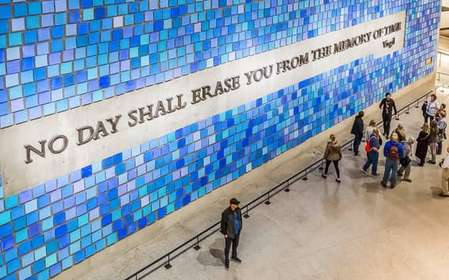- Home
- Useful Tips
- Visiting 9/11 Memorial with...
Visiting the 9/11 Memorial with children presents unique challenges that 63% of parents report feeling unprepared for. The site's profound emotional weight clashes with young visitors' needs for engagement and comprehension, leaving caregivers torn between educational value and emotional protection. Unlike typical NYC attractions, this experience requires careful consideration of a child's age, maturity level, and prior knowledge of historical events. Many families unknowingly arrive during peak hours when crowds amplify the solemn atmosphere, or miss the preparatory resources that could transform a potentially overwhelming visit into a meaningful learning moment. The memorial's design elements – from the endless voids of the reflecting pools to the Survivor Tree's symbolism – demand contextualization that standard guidebooks often overlook.


Preparing children emotionally before your visit
The key to a successful family visit lies in thoughtful preparation tailored to your child's developmental stage. For children under 10, focus on simple concepts of remembrance and heroism rather than detailed explanations of violence. Elementary schoolers benefit from reading age-appropriate books like 'The Man Who Walked Between the Towers' beforehand, which frames the site's history through wonder rather than fear. With teens, consider watching documentary footage together and discussing how memorials help societies heal. New York child psychologists recommend gauging your child's anxiety levels by their questions – if they express concern about safety, emphasize the memorial's role in protecting future generations. Many local families visit the nearby FDNY Memorial Wall first, which provides a gentler entry point to discussing community helpers' bravery.
Navigating the memorial's physical space with kids
The memorial's vast plaza presents practical challenges, from navigating crowded pathways to finding quiet reflection spots. Arrive before 11am or after 3pm to avoid school group crowds, and locate the less-visited North Pool first – its identical design offers more space for initial adjustment. Stroller access is excellent, but consider baby carriers for closer viewing of the names inscriptions. The memorial's audio guide includes a family-friendly version that explains symbolism through stories of rescue dogs and survivor reunions. For tactile learners, the bronze parapet surrounding the pools invites touching while reading names. Nearby Liberty Park offers breathing room with its elevated walkway and view of the Survivor Tree, where children often connect with the sapling's resilience metaphor more easily than the vast voids below.
Making museum exhibits meaningful for young minds
While the 9/11 Museum's historical exhibition isn't recommended for children under 8, the memorial exhibition on the concourse level provides thoughtful alternatives. The 'In Memoriam' section's tribute wall allows kids to leave drawings alongside visitor messages from worldwide. Interactive tables let children explore the memorial grove's bios of victims, often focusing on shared interests like sports or pets. The Foundation Hall's Last Column becomes more relatable when kids notice the missing person posters and firefighter signatures preserved on its surface. Many families spend just 20 minutes in the museum proper, then continue discussions at the adjacent FDNY Ten House fire station where firefighters often share age-appropriate stories of September 12th's hope and recovery.
Continuing the conversation after your visit
The memorial experience often lingers with children through unexpected questions days later. Local educators suggest processing through creative activities – sketching the Survivor Tree, writing thank-you notes to first responders, or comparing the memorial to others you've visited. The nearby St. Paul's Chapel offers a peaceful post-visit stop where kids can see the 'Thread Project' banners sewn by worldwide children after 9/11. Consider following up with hopeful stories like the Boat Lift evacuation or the Tribute in Light annual ceremony. Many NYC families make an annual tradition of visiting the memorial's birthday roses – small red blooms placed on victims' birth dates that help children connect to individual lives rather than abstract tragedy.



